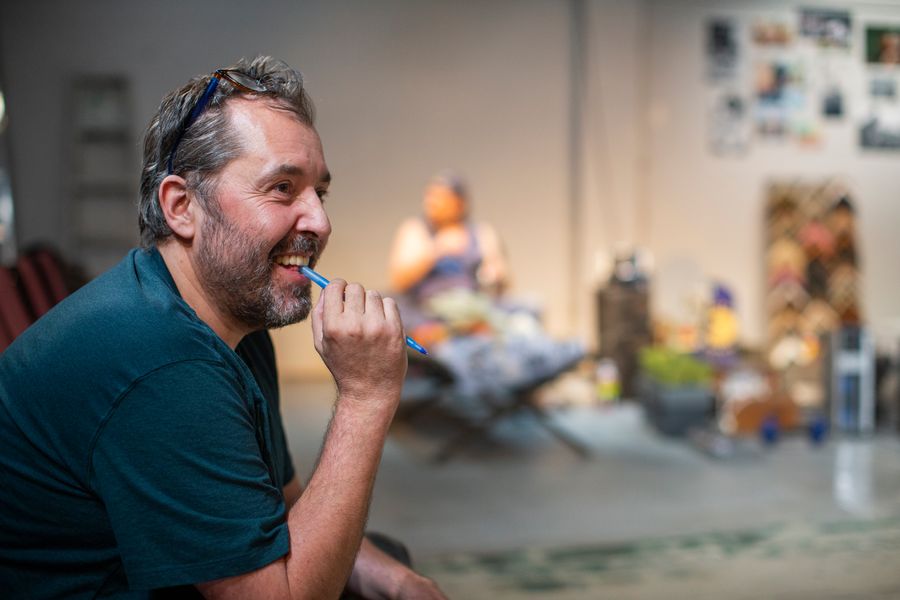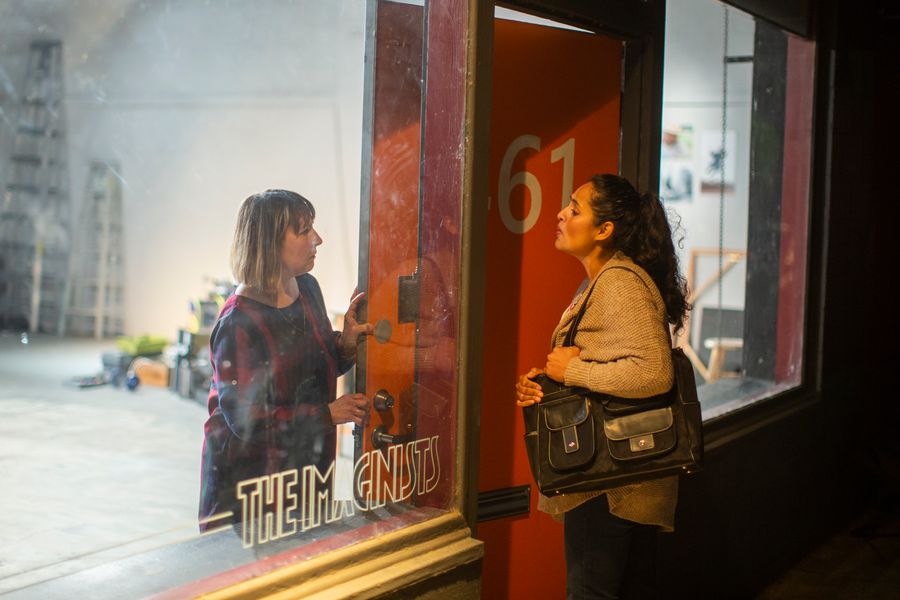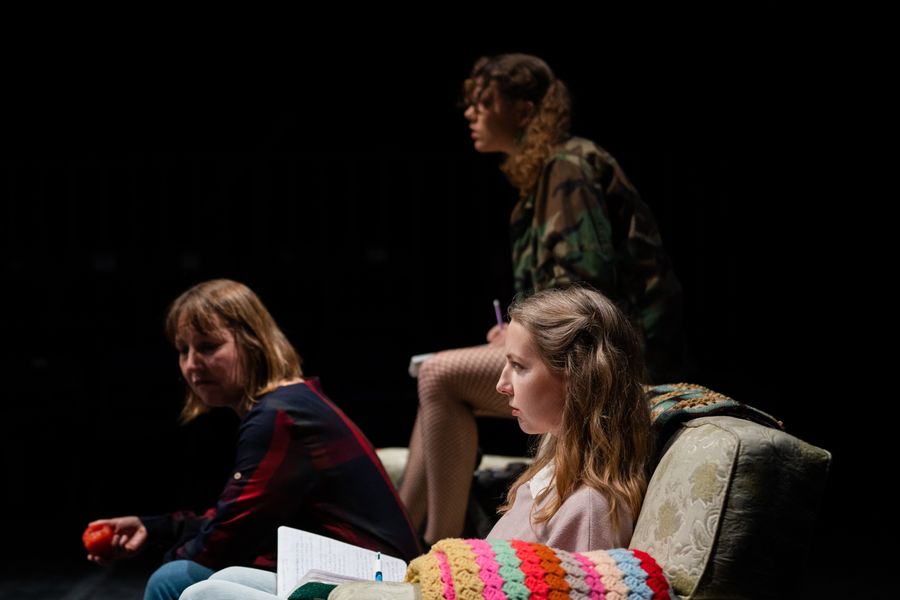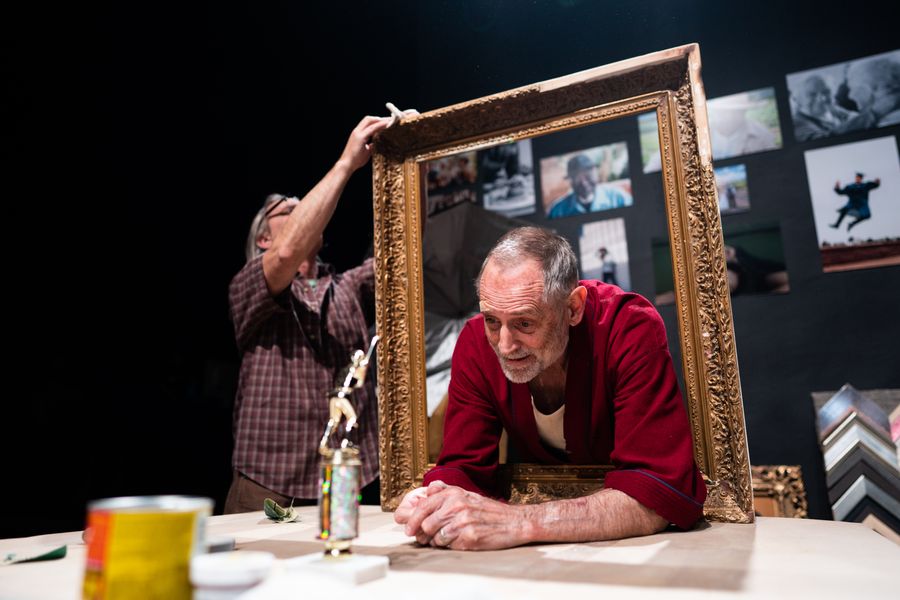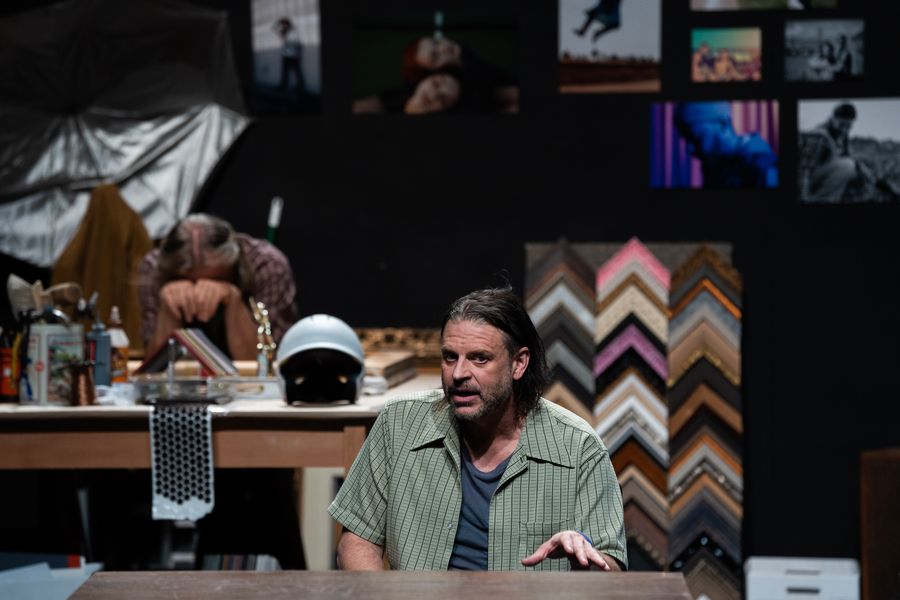From the darkness some distance offstage comes a sound, mournful and insistent, and slowly approaching. A man appears, beating out a delicate rhythm on a piece of corrugated tin and humming low. Pacing the stage, whose few elements suggest a household as well as a photographer or frame maker’s workshop, the troubadour (Stephen K. Patterson) erupts into song, his first lines arcing like signal flares:
I recognize the bright light
Of a disturbing idea
And if the soul is right
I’ll release my fear
This last word dissolves into a brief silence, before the balladeer continues:
And it wouldn’t be a song if I didn’t sing it
And it wouldn’t be a problem if you didn’t have it
And I couldn’t be a witness if I didn’t see it
One quick flash and the blink of an eye
And
Someone dies
Someone dies
Someone dies again
Every single god damned day
Someone dies
Every single god damned day
Someone dies again…
The world premiere of S D A (Someone Dies Again), which completed its run June 11, was a co-production of European director Árpád Schilling and the Imaginists, a Santa Rosa, Calif.-based theatre company. A sly, dreamlike, and intense meditation on American gun violence, the premiere ran consecutively at two venues: Z Space in San Francisco (May 20–28), then at the Imaginists’ performance space in Santa Rosa (June 2–11). It was a timeline punctuated with oppressive consistency by the country’s latest onslaught of mass shootings, including Buffalo (May 14) and Uvalde (May 24).
Though it inevitably felt in part like a response to those massacres, the piece had a longer gestation, of course: The devising of the story and script, a collective process among the playwright-director and a 12-member ensemble of local actors, was four months in the making. Preceding it were seven years of conversations and two years of pre-production planning among its instigators, Schilling and Imaginists founding co-artistic directors Brent Lindsay and Amy Pinto. Indeed, the full arc is 10 years if you consider the earliest origins of this unlikely international collaboration.
My own involvement in the project goes back a bit as well: I began following the Imaginists and Schilling over a decade ago as a journalist, and was asked late last year by Lindsay and Pinto to help to document and publicize the production, which after years of bureaucratic delays and personal and public health emergencies was finally going forward.
The request made sense, given my proximity to the project’s history and grasp of the wider context in which it sits. Having been eager to see this unique partnership come to fruition, I agreed to join the effort, consulting on communications and co-producing (with Imaginists co-artistic director Stephen K. Patterson) a podcast to help build awareness of this exceptional project. I also pitched this story to American Theatre, which agreed to accept an account from my embedded perspective.
It was only later that the plot thickened when I was unexpectedly cast in the role of the Lawyer. Maybe not so much of a stretch from the role of critic, but the jury is still out.
Through the Bright Orange Door
Árpád Schilling left his home in Southeastern France and arrived in Santa Rosa in the first week of February, accompanied by his 13-year-old daughter. They settled into a small rented house secured for them by the Imaginists directly across the street from the company’s 50-seat storefront theatre on Sebastopol Ave., in a modest residential neighborhood that doubles as the South A Street Arts District.
A former commercial warehouse, the Imaginists moved into the space in 2007 and managed to purchase in 2018, following a capital campaign made possible with assistance from the Hewlett Foundation and the Northern California Community Loan Fund. The storefront’s plate-glass windows and bright orange door open directly onto a rectangular performance area, beyond which is a narrow costume room cum workshop and a small upstairs office. Stepping through a fire door at the back of the theatre, one enters a warren of tiny studios off a connecting hallway that also serves as a gallery for the artist-tenants. The end of the hallway opens onto mural-embellished Art Alley.
It was in the empty space at the front of the building that, over the next four months, the Hungarian-born director, together with Lindsay and Pinto, would lead the process of casting, conceptualizing, jointly creating, and finally staging the new work.
This much had been the plan ever since Schilling and his wife, actress Lilla Sárosdi, first visited Lindsay and Pinto—who, like Schilling and Sárosdi, are a couple with two children—in their Santa Rosa environs in April of 2015. A friendship was forged that, as Schilling related at the time, made the idea of working together both attractive and feasible.
The visit in 2015 was hardly something Pinto and Lindsay could have predicted or even dreamed of a few years before. The Imaginists had operated for more than a decade as a small, community-based bilingual theatre company, and Schilling was an internationally renowned theatremaker and political dissident, the founder and director of a world-famous company, Krétakör (1995–2008), who was in high demand across Europe since going freelance and leaving Hungary. Surface differences aside, 2015’s encounter made clear there was significant common ground between them, especially a commitment to community-based work, to exploration that plumbed the personal histories of the performers and creators themselves, and to always changing, always questioning.
The fateful 2015 visit had come about through a series of encounters going back to March 2012, when Pinto joined a group of theatre artists and journalists (myself included) for a showcase of Hungarian independent theatre in Budapest, as guests of Philip Arnoult’s Center for International Theater Development (CITD). In addition to the impressive work she saw on that trip, hearing Schilling speak had been a high point of the trip for Pinto, who recounts in the first episode of the S D A podcast coming back from Budapest convinced the Imaginists had to shake things up, to move into a new phase of work somehow. But while the possibility of trans-Atlantic collaborations between American and Hungarian independent theatres had been part of the reason for the 2012 trip, it did not directly spur one, at least not at first.
It would take two more international encounters—impossible to detail here, but recounted by Pinto and Lindsay in the podcast—to coax Schilling into making an exploratory visit to California. That 2015 meeting took place against the backdrop of recent uprisings and unrest in Ferguson, Mo., stemming from the lethal police shooting of Michael Brown in 2014. This roiling context—and the Imaginists’ own exploration of a 2013 police killing of a local Latino boy, Andy Lopez, in their play The Party—strongly suggested an area of investigation for the budding partnership. Conversations about racism and systemic violence in the U.S. ultimately came to focus on the gun itself—on its role in the culture and in a peculiarly American epidemic.
What Was in the Room
Feb. 11 was Day One of the first workshop. In lieu of a typical audition, Pinto and Lindsay invited more than a dozen actors to join them for three six-hour days under Schilling’s direction, the expectation being that at the end Schilling would have an ensemble of actors with whom he would create the play, which had the working title The Shot. The process almost worked: Ultimately a second workshop was called the following week with a subset of the actors from Week One.
The only sure thing at this point was that Lindsay and Pinto would be in central roles—Schilling’s wish, and something of a luxury for two adventurous actors who normally split duties directing, writing, and producing their own work. They saw it as a chance not only to learn from Schilling but to push themselves beyond—well beyond, it would turn out—their former limits.
Most of the other actors at the workshops had a connection to Lindsay and Pinto. Some had worked with the Imaginists before. Patterson, a musician and composer as well as actor, who had recently come on board as co-artistic director, is a colleague from the salad days of their Delaware-based collective, Knights of Indulgence Theatre United States (KITUS). At least two other actors in the room reached back to similarly early years.
There as an observer, I was invited to participate in the workshop’s discussions and exercises. The latter consisted of a series of situations and conditions set by Schilling, in which actors were asked to quickly devise and improvise scenes based on his instructions. At regular intervals, the entire group circled up chairs for a talk, elaborating on the themes Schilling wanted to explore: the power dynamics of American culture, racism, sexism, homophobia, liberal orthodoxies, left censorship, cancel culture, the half-dominant, half-beleaguered position of the white male. The days were exhilarating and exhausting by turns.
The two weeks of workshopping ended up not only solidifying a diverse ensemble, but also kickstarting important research. Schilling had brought a two-page treatment, the germ of a story penned some months back and inspired by the Kyle Rittenhouse case, then in the news and a topic of the collaborators’ regular conversations. The treatment concerned a conservative white family with a wayward son who dies in a violent act.
In the end, Schilling threw out what he brought into the rehearsal room in favor of what he found there. He came up with a fresh two-page proposition for the newly constituted ensemble, which began to look a lot more like the people and neighborhood he was coming to know. Set in a non-specific North Bay town with a substantial Latino population, his new scenario would depict a liberal white family who has their values tested in the wake of the son’s death and the ensuing impact of grief, alienation, and a culture of violence.
Ironically, my non-actorly demeanor gave the director an idea for an outsider character, which is how I ended up being cast, and in a not-inconsequential role. I would play a mysterious Lawyer with a cloaked political agenda and vague promises of social redemption, setting the family, and especially the father, Marty, on a course of self-destruction.
The proposition was accepted by all, and rehearsals began as a set of recorded improvisations based on the story outline. After weeks of rehearsal, Schilling shut down activity for four days to hole up in the house across the street, where he labored to turn dozens of hours of recordings into a working script.
In S D A (Someone Dies Again), as the play was now titled, the issue of gun violence is approached less as a political or historical problem (despite research and discussion of this context along the way) than as a social, psychological, and existential one. Centered on the family as the essential unit or microcosm of a deeply divided society, it establishes a familiar world, only to turn the viewer’s gaze inward, to our basic nature and our most intimate experience of self and other.
Although a work of fiction, with surrealist elements and oblique literary and filmic references, the play’s meat and bones came to no small degree from the lives, personalities, imaginations, and perspectives of the 12 ensemble members, as well as of the playwright-director himself. This would become even more the case through subsequent rehearsals, as Schilling relied on his American cast to correct or refine the script’s language and idioms (which he composed with assistance from a translation app).
Some actors—like Tessa Rissacher, who originated the role of the Lecturer; or John Craven, who originated the role of Leo, Marty’s father, who returns as a ghost or figment of his mind; or David Roby, who originated the role of Marty’s loose cannon of a brother, Larry—took on exceptional responsibility for crafting their characters’ dialogue. And in regular and intense discussions, the scenes and characters of the story became ever richer, more nuanced, and more interdependent. The final result is a script that holds its own as a work of literary art.
The Keller family comprises Marty (Brent Lindsay) and Gena (Amy Pinto) and their daughter Maddy (Emma Attwood). A hobbled nuclear unit, a little precarious but still standing, like a three-legged version of the dining room table at the center of the set, they are the survivors of a tragedy six years earlier in which son and older brother Miles died in an apparent accident during an altercation he appears to have provoked with a Latino peer. The trauma initially left Gena suicidal and unable to go on working as a schoolteacher, though at the start of the play she is beginning to feel able to teach again. Maddy, who was just a child when her brother died, is now in college, and lives with her girlfriend Chelsea (Karina Pugh) a bus ride away from her parents, whose attention and respect she clearly craves, perhaps in an enduring competition with her dead brother.
Hovering nearby but apart, meanwhile, is Marty’s brother Larry (David Roby), burned out of his trailer park by the recent North Bay fires and living and working in a corner of Marty’s workshop, a former photography studio that now principally makes frames and repairs old radios and turntables. (Photographic portraits of a diverse set of people adorned the wall of the show’s scenic design, an echo of a community from which the family was estranged, or perhaps an ideal that never existed.) Larry’s paranoia and casual racism, as well as his childlike fascination with old video games and toys, make him an uncomfortable and unacknowledged stand-in for the missing boy. Unsurprisingly, he is kept at arm’s length from the family hearth.
Into the mix comes a Lawyer (John Most, to give him my stage name), who contacts Marty with a suggestion that his son’s death may have been part of a larger pattern of mismanaged cases by the local district attorney—part of a progressive agenda, it is implied, that is “putting politics before justice.” Marty at first defers to his wife and daughter’s reluctance to revisit the traumatic incident in so public a way. But he’s soon visited by the tortured ghost of his angry, abusive father, Leo (John Craven), and driven, Hamlet-like, to push for “the truth.”
So begins a pact with the Lawyer that spirals horribly out of control, further unsettling the family’s standing among their Latino neighbors, destroying intimate relationships and throwing strangers together in distressing opposition to one another, including a young Latino worker caught in the crossfire (Alexsandro Bravo) and a Latina mother (Zahira Diaz Garibay) whose own son is threatened by the machinations set in motion by the Lawyer. The final scene features the return of a gun confiscated from Larry in Scene One.
The San Francisco run at Z Space was set within a great gray rectangular box of light designed by Gabe Maxson. Audiences were invited to sit on the large stage in two double rows of seats on either side of the playing area. The cavernous, formerly industrial space was an infinite void beyond.
Schilling’s staging mingled naturalistic and poetical elements. Larry, for instance, by turns an alarming and whimsical presence, cooked soup and Pop-Tarts in his slovenly corner of the stage, and a moment later placed a bucket over his head to become a human bullet aimed straight at Gena. Action took place around, under, and on top of the central table, which stood in for the Keller home one minute, and the next a local grocery store owned by Gena’s former student Cecilia (Yareny Fuentes), or the bar owned by Marty’s friend Ken (Patterson), a former cop. Patterson, also the show’s bard and composer, smoothly transitioned in and out of the role of Ken from the half-shadowed edge of the stage, where he was otherwise an ethereal presence controlling the soundscape from an iPad. Scenes overlapped and intertwined at times in ways that suggested a cinematic dissolve yet allowed for the passing interaction between characters otherwise separated in time and space.
Within this world of inner and outer landscapes, the play unfurled a story in 16 uninterrupted scenes, all equally mercurial in their shifting tones and leading to an inexorable, howling climax. Audiences tended to linger in their seats at the end, and often reacted expansively, both immediately after the show and online. The catharsis was evidently needed, and many said so explicitly. As word of mouth grew, the final shows in Santa Rosa sold out.
A Dramaturgy of Fragility
Significantly, the word community is mouthed by almost every character in S D A. The word is repeated so often, in varying contexts and with various inflections, that its meaning wholly dissolves—and reconstitutes itself as a question floating above the stage. In many ways, it’s the more formidable question arising in a play whose impetus was an investigation of runaway American gun violence.
The theme of gun violence is hardly abstract. At least one member of the cast shared early in the process how gun violence directly impacted her family. But Schilling was after more than a documentary record or a reflection of the day’s headlines. He needs to move beyond incendiary yet ossified opinions and debates. To stir his audience awake, to invite a new angle of reflection, to explore the ineffable side of the too familiar, he required the provocation of poetry.
“The theatre has its own language, something very international and absolutely out of any specific cultural context,” he told me. “We have to push the theatre into different cultural contexts, but the theatre itself is something that is just a scandal. I think the theatre is good if it’s a scandal.”
Schilling’s many talents as a director include an unsettling perspicacity: an ability to quickly perceive the qualities, social tendencies, and ego logic of the people in the room, and to set those forces going in a specific direction, to bring them to the fore and put them into dynamic relation with others. My own hesitation in turning actor on this occasion quickly dissolved when Schilling explained the usefulness of my artlessness for completing a story that needed a motivating factor from outside of its otherwise familial and familiar setting—something which, cipher-like, could stand for the Law, the State, the Media, the Devil, or what have you. Something that in holding the mirror up to a character’s nature could serve an alchemical end, to turn one’s self, one’s family, one’s community into a question.
Memorial Day, May 30, was Schilling and his family’s last day in California. They returned home to France the day after, and from there Schilling traveled immediately to Slovenia to direct his next project, a play about the moral compromises made in the ascent to power.
We had completed the San Francisco run the previous Saturday, and most of Sunday was spent striking the set with members of the ensemble, followed that evening by a farewell party for Árpád and family at the Imaginists’ theatre. The Santa Rosa leg of the run would start Thursday, in the space where the piece had been built.
Memorial Day afternoon, Brent Lindsay sat at the dining room table, which was once again back at the center of the room and the stage; Amy Pinto was on the sofa at the edge of the stage. Árpád, visible through the front windows, made the short walk from the house across the street to the storefront theatre for the last time. He joined Brent at the Kellers’ dining room table, framed by the neighborhood visible through the front windows.
We talked for two hours about the production, the process, the themes of the play, where they came from, how it all turned out, what it all means. I asked Schilling how different this process was from what he was used to. Doesn’t he usually rely on a dramaturg, for instance?
“But I have to say, there was a dramaturg,” he replied. “You were a dramaturg; Tessa was a dramaturg; Amy was a dramaturg. What is the task of the dramaturg? Research and having some handle on the process theoretically, aesthetically, as a written thing. I remember we would talk about a sentence or a word and its ideological significance or political complexity, asking how we can say it in English—this is the work of the dramaturg.” He said he counted the project lucky to have “lots of dramaturgs, because we incorporated this talk, talking all the time, so we could control each other.”
Schilling underscored the importance of having a group of people willing to work together and push past their vulnerabilities and fears. He had expressed this sentiment to the cast the night before, saying that his experience in Santa Rosa had reminded him of working with his former company, Krétakör—a complement not lost on Pinto and Lindsay, who were originally inspired to reach out to Schilling based on the recordings they had scene of the famous ensemble.
“The fragility of my work is that I’m very interested in the people,” Schilling explained. “Honestly, for me, it’s very scary. I don’t like myself sometimes, when after work I go home and I feel like, okay, he was so upset, she was so—why do we do this? I don’t want to hurt people.
“But the fragility is at the center of the art and its quality. Sometimes we need this. I have to know the people, know who they are, what they want, how they speak, how they feel, how they talk to each other—because in that case I can work much better with them. I like very much when we can talk, and we can go deeper and deeper. But it’s very fragile. This is why I always tell people, if they ask me to work with them, ‘Okay, but I don’t know if it will be good or not. I don’t know if it will be a success or not.’”
“You came in as a writer and director with ideas,” Lindsay told Schilling, “investigations that then became our investigation. You brought very personal situations [to the character of Marty] that I could identify with. So it became my investigation. And that was painful at times. But hopefully what we’re doing is passing that on to an audience, who then is going to have to investigate themselves.”
“This is the difference,” agreed Schilling. “I could have an idea, and then try to find people who fit the concept. It can work in the case of a film. I can imagine a character, and then say, you are better than someone else to play this concept. But in the theatre, when we have to be together for a long time, it’s more interesting to read the people first. To say: Who are you? It’s like the first question in Hamlet, the big question: Who’s there? In our age, maybe this is what’s necessary, and braver—not to talk about other people but to talk about ourselves. Maybe what is truly progressive is to ask, Who are we? Who’s there?”
Robert Avila (he/him) is an arts writer based in the Bay Area and Europe who has covered theatre, dance, film and performance for American Theatre, San Francisco Bay Guardian, San Francisco Chronicle, In Dance, and other publications since 2002. He was the Bay Guardian’s senior theatre critic from 2004 to 2014. He is dramaturg and co-artistic director for the Warsaw-based international live arts producing and presenting platform Eldorado. He also writes at povertyartsjournal.com.


